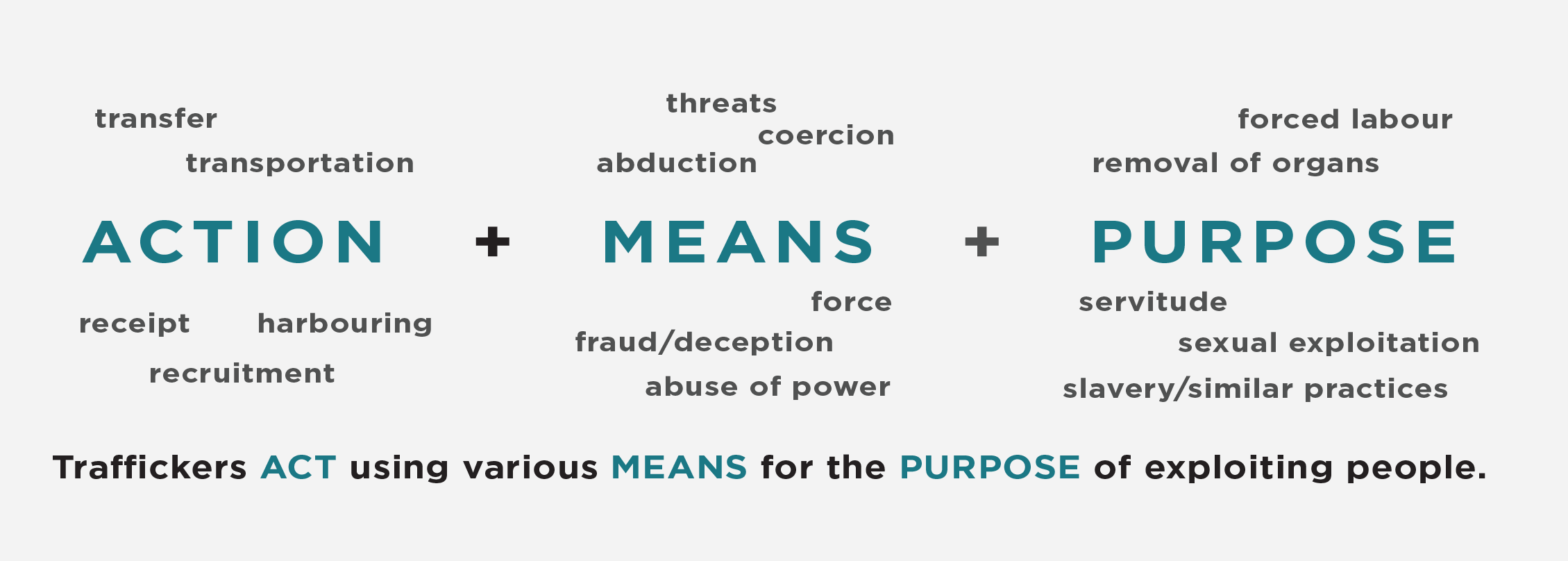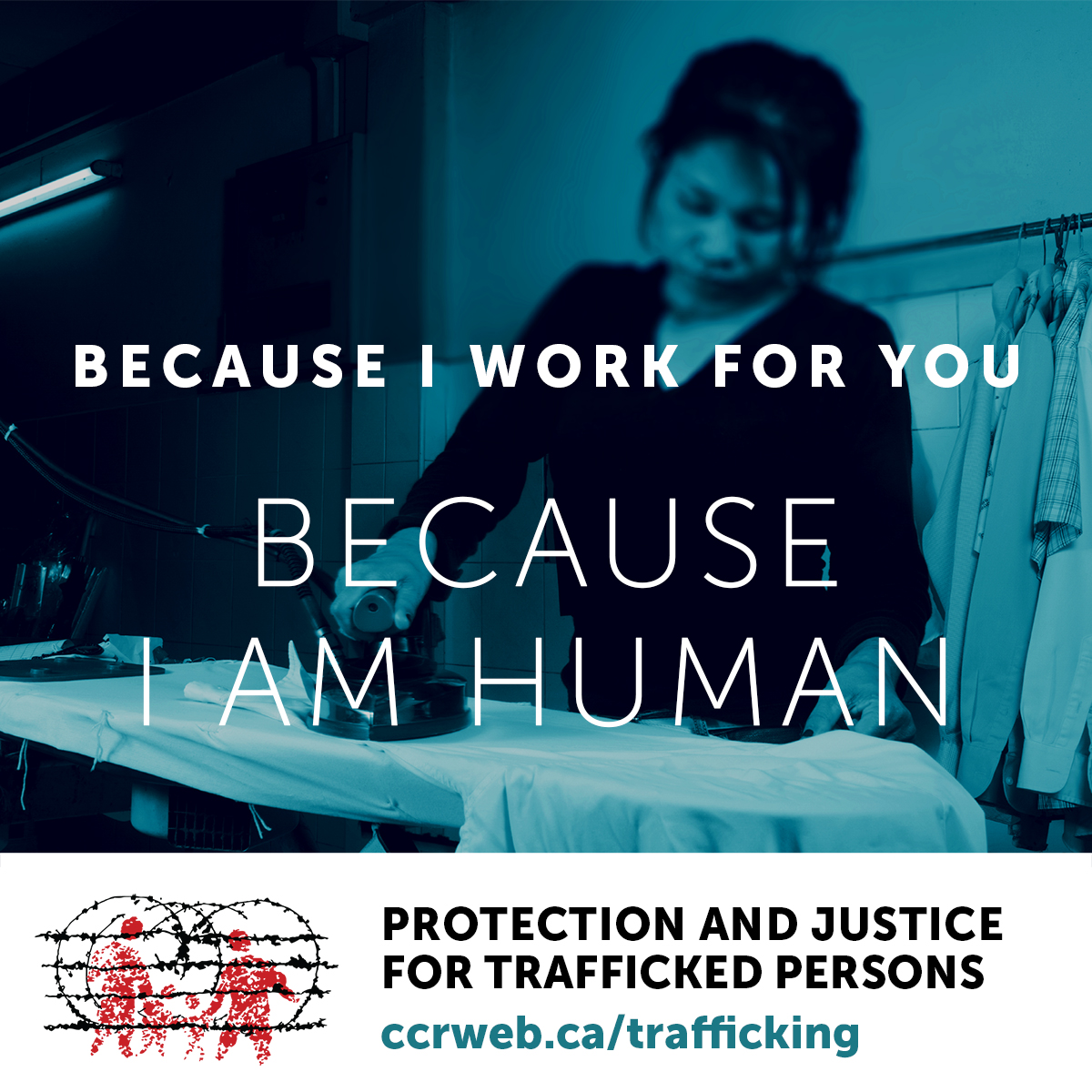-
About us
-
Member hub
-
Directory
-
-
Issues and resources
-
Recent Information
-
-
Take action
-
Take action
-
Outreach
-
-
Events
-
Meetings
-
Webinars
-
Migrant workers
Campaign
Temporary workers
Source
CUPE
Trafficking in Persons for Forced Labour: Backgrounder
Introduction: Trafficking in persons
Trafficking in persons occurs when someone obtains a profit from the exploitation of another person by using some form of coercion, deception or fraud. Exploitation can take many different forms, including through forced labour in various areas such as the service, manufacturing, agricultural or construction sectors, through domestic work, and through work in the sex industry/prostitution. Regardless of the form of exploitation, trafficking in persons is a violation of a person’s basic human rights and it affects men, women and children.
This document aims to give information about how trafficking for labour exploitation can take place in Canada.
Global context: Trafficking for forced labour
 Trafficking for forced labour happens in a context of both global and local economic inequalities where many people are looking for ways to better protect and provide for themselves and their families.
Trafficking for forced labour happens in a context of both global and local economic inequalities where many people are looking for ways to better protect and provide for themselves and their families.
Around the world, approximately 21 million people are in a situation of forced labour. Most of these individuals are exploited by private individuals or businesses. A minority of people are forced to work by state entities. Women are overrepresented among forced labourers globally.[1]
Root causes of trafficking are often socio-economic or political. Poverty, conflicts, inequalities (including based on gender) and persecution are among the common contexts. While many people find themselves in situations of forced labour in their home communities, these root causes often push people to migrate in search of opportunities.
Increasingly restrictive immigration rules worldwide make it more difficult for people to migrate safely and make many migrants more vulnerable. Traffickers take advantage of these situations by exploiting the very limited options and lack of legal and social protections that are available to migrants.
Forms of labour trafficking
 Trafficking for the purpose of labour exploitation takes place when some means (including taking advantage of a person’s particular vulnerabilities) are used as a way of controlling someone in order to cause them to believe that they have no choice but to carry out a specific work or service.
Trafficking for the purpose of labour exploitation takes place when some means (including taking advantage of a person’s particular vulnerabilities) are used as a way of controlling someone in order to cause them to believe that they have no choice but to carry out a specific work or service.
The following shows what the various elements involved in labour trafficking might look like concretely.
An action whereby a person is:
- Recruited by an individual or organization, and often charged large fees and persuaded to take on a large debt in order to get a job;
- Moved from a country to another (or within a country).
A means whereby a person:
- Is deceived through attractive promises (such as a good job or educational or other opportunities) only to find that the promises are false or that conditions (such as work and pay) are much worse than advertised;
- Is isolated in order to control her/his freedom of movement and ability to contact other people, including family and other members of society, and is constantly monitored;
- Is intimidated by threats of being underpaid, not being paid at all, or having penalties deducted; by threats of physical violence, denunciation to authorities and deportation; and through harassment in order to control the person and ensure that they comply;
- Has her/his passport, identity documents and work permit taken from them;
- Has her/his specific vulnerabilities taken advantage of, including a person’s lack of viable economic or employment options, a situation of indebtedness, language barriers, or a person’s separation from loved ones and from her/his support networks.
- Is forced to participate in illegal activities such as fraud or stealing, in order to criminalize them as another means of control.
Exploitation, whereby a person is:
- Underpaid, not paid at all, or whose wages are deducted unjustifiably (such as for wildly overpriced housing);
- Forced to work unpaid overtime;
- Charged large, fraudulent recruitment fees;
- Manipulated into a situation of debt through a loan, wage advance or fraudulent fees charged to keep the person under control and in a situation of bonded labour;
- Sold to different employers by recruiters or agents.
The people involved are not always just the employer or recruiter: acquaintances, neighbours and family members can also play a role.
Labour trafficking in Canada
Migrant workers and labour trafficking
In recent years, Canada has increasingly shifted its focus from permanent to more precarious temporary immigration. More workers are now being brought into Canada on a temporary basis with fewer rights than other workers to fill labour needs. These conditions and the lack of employment options available to them have made migrant workers extremely vulnerable to abuse and exploitation.
Trafficking in persons is the most extreme form of exploitation faced by migrant workers in Canada.
In Canada, trafficking for the purpose of labour has predominantly affected migrant workers. Those most affected by abuse and exploitation often come with valid work permits under the “low-skilled” streams of the Temporary Foreign Workers Program (TFWP), including the Low-wage and Primary Agricultural Streams and the Live-in Caregiver Program. Temporary Foreign Workers employed under these streams may be employed in restaurants, hotels or other hospitality services, on farms, in food preparation, in construction or in manufacturing, as well as in domestic work.
Vulnerabilities of Temporary Foreign Workers to trafficking in persons
The TFWP conditions place migrant workers in a situation where they are vulnerable to exploitation and trafficking. These conditions include:
- Lack of permanent status, putting workers in a precarious situation, with limited protection of their rights or opportunity to complain about mistreatment.
- Employer-specific work permits tie migrant workers’ immigration status to a single employer, causing them to risk deportation if they leave their job. This limits complaints and the prospect of seeking alternative job options in case of mistreatment and unpaid wages.
- Housing is often provided by, shared with, or in Live-in Caregivers’ cases is tied to an employer, making it easier to isolate workers, to extract money through rent, and exploit their labour.
- Physical and social isolation, exacerbated by language barriers that make it difficult to establish community connections.
- Limited access to services.
- No access to language and legal training, education, or federally funded settlement services.
- Lack of monitoring and enforcement, which has made it easier for illegal practices to take place, such as the charging of large recruitment fees, resulting in substantial debt and indentured labour.[2]
Unfortunately, the changes introduced to the TFWP in June 2014 do little to strengthen protection measures for workers. Although some enforcement and monitoring measures have been added, the program continues to rely overwhelmingly on a complaints system that migrant workers are unlikely to use as this can still lead to deportation.
The shift towards more restrictive immigration policies in Canada has also created additional opportunities for people to be trafficked for the purpose of forced labour, by creating additional vulnerabilities that traffickers take advantage of.
Refugee claimants and labour trafficking
Some trafficked persons are forced by their traffickers to make a refugee claim, which is either meant to fail or is not pursued, so that the person is subject to removal. This facilitates traffickers’ ability to threaten and control trafficked persons in order to exploit their labour in different ways.
Recent changes to the Immigration and Refugee Protection Act bar people whose refugee claims have been rejected, withdrawn or abandoned, from applying for status, including the Temporary Resident Permit intended for victims of trafficking.[3] This has made it harder for trafficked persons to escape their traffickers and easier for traffickers to control them through threats of denunciation and deportation.
In 2010, 23 Hungarian men were trafficked to Canada. They were forced to make refugee claims, their documents were taken away and they were made to work on construction sites up to seven days a week without pay and to participate in criminal activities. They were threatened and some were physically assaulted. They were monitored, controlled and forced to live in the basement of their traffickers’ homes.
Had they faced the new legal barriers, they likely would not have received protection in Canada.
Family and domestic situations
Trafficking for forced labour also takes place in situations where a person is forced into domestic servitude by family members or by others outside the family. Such cases can include:
 Children forced to work at home or exploited in other ways;
Children forced to work at home or exploited in other ways;- Domestic servants accompanying their employers into Canada, coerced into unpaid labour;
- Spouses, parents or grandparents exploited financially and/or forced to do work inside or outside the home, under threats of violence or deportation. The new Conditional Permanent Residence policy places some sponsored spouses in a more vulnerable position.[4] Forced marriages may also be used as a means to exploit a spouse.[5]
Labour trafficking and precarious immigration status
People with insecure immigration status or no status at all are particularly vulnerable to trafficking for their labour. Whether they enter as a Temporary Foreign Worker, a refugee claimant, a student, a tourist or irregularly, traffickers may take advantage of their limited rights in Canada and the threat of detention and deportation, to force them to carry out work.
Due to changes in immigration policy, more people are in Canada with temporary and precarious status.
Possible solutions
The risk of trafficking can be reduced, and recourses for those who are trafficked improved by:
- Increasing access to permanent status;
- Expanding the rights of those with temporary status and enforcing laws to protect them from abuse;
- Introducing legal protections for trafficked persons without secure immigration status in Canada.
[1] International Labour Organization (ILO) 2012 Global Estimate of Forced Labour: http://bit.ly/1wreu9s.
[2] See Profiting from the Precarious: How recruitment practices exploit migrant workers, Metcalf Foundation, available online: http://bit.ly/QnrPBt.
[3] Canadian Council for Refugees, Access to Protection for Trafficked Non-Citizens: ccrweb.ca/en/protection-trafficked-persons
[4] Canadian Council for Refugees, Conditional Permanent Residence: ccrweb.ca/en/conditional-permanent-residence
[5] See Resource Information Guide to Human Trafficking Systems through Forced Marriages, South Asian Women’s Centre (SAWC): ccrweb.ca/en/resource-information-guide-human-trafficking-forced-marriages
Issues
Format
Migrant Worker Issues: Some international context
Summary
The CCR has had an active campaign for the rights of migrant workers in Canada for the last ten years. The campaign has focused on the protection of migrant workers’ rights in Canada, and their access to permanent residence and to services. Since temporary labour migration is a global phenomenon, the CCR is beginning to get involved in migrant justice activities outside of Canada’s borders. Let’s take a closer look at the global dynamics of labour migration...
Issues
Format
Temporary Foreign Workers: the broader context
Introduction
Canadians have recently had their attention drawn to serious problems with the Temporary Foreign Workers Program. It is useful to look at these issues in the broader context.
From permanent to temporary
Over the past decade, Canada’s immigration program has shifted significantly from permanent to temporary immigration. In 2008, for the first time, the numbers of Temporary Foreign Workers in Canada exceeded the number of Permanent Residents admitted. Since then the number of Temporary Foreign Workers has continued to grow.
Newsletter type
How the Conservatives expanded the temporary worker pipeline
Campaign
Temporary workers
Source
Canadian Labour Congress
2013 in Review: Refugees and immigrants in Canada
2013 was marked by increasing vulnerabilities for many refugees and immigrants in Canada, with status often harder to acquire and easier to lose, and with a heavy emphasis on economic priorities over family reunification and refugee protection.
New refugee claim system: short timelines, two-tiered system
2013 was the first year of a new refugee determination system. While the new system is fast and fair for some, its short timelines and complex rules are causing serious problems for others.
 The short timelines create high levels of stress. Many claimants are unable to prepare themselves adequately for their hearing. The timelines are particularly damaging for vulnerable claimants, such as survivors of torture, and for claimants fleeing persecution based on gender or sexual orientation.
The short timelines create high levels of stress. Many claimants are unable to prepare themselves adequately for their hearing. The timelines are particularly damaging for vulnerable claimants, such as survivors of torture, and for claimants fleeing persecution based on gender or sexual orientation.- Two-tier system: Some claimants have less access to protection, based on where they are from. Refugee claimants from Designated Countries of Origin have even less time to prepare their case, limited access to services and restricted legal recourses.
- Access to health care: cuts to the Interim Federal Health Program in 2012 compound the difficulties faced by claimants in the new system.
- The number of people making refugee claims in Canada went down dramatically in 2013. Final figures for the year will likely be at a record low.
Lack of safeguards before deportation
The government has invested more resources in quick deportations, while new rules remove safeguards to prevent deportations in cases with new evidence of risk or compelling humanitarian factors. The law considers best interests of the child or life-threatening health conditions, but the person can be deported before they are considered!
Reduced access to protection for trafficked persons
Restrictive new laws are hurting people trafficked into Canada who are trying to escape the criminals exploiting them. Temporary Resident Permits are designed to protect trafficked persons, but they are no longer available to people making a refugee claim, which traffickers force their victims to do at times. Citizenship and Immigration Canada acknowledges this and says it is looking for a solution.
Migrant workers: temporary status makes them vulnerable to abuse
Traditionally a country of permanent immigration, Canada has shifted dramatically towards temporary migration. Workers in “low-skilled” streams of Canada’s Temporary Foreign Worker Program, including many women, are vulnerable to abuse and exploitation, even trafficking.
- The CCR’s Migrant Workers: Provincial and Federal Report Cards, published in 2013, highlight important gaps in protection of migrant workers’ basic rights in Canada. Happily some provinces are adopting measures to address some of these gaps, but there is much more to do.
- Changes to the Canadian Experience Class make it more difficult for some temporary workers to make a permanent home in Canada.
Permanent residence is becoming less permanent
New immigration rules mean that it is much easier to lose permanent residence – in many situations.
- Conditional permanent residence for some sponsored spouses and partners. 2013 marked the first year of this new policy. If a couple does not remain together for two years, the sponsored partner loses status and can be deported. Although there are exceptions in cases of abuse and neglect, concerns remain that this policy makes women especially vulnerable to abuse.
- After committing a crime. Changes in 2013 mean that more permanent residents have no way to appeal their removal, even if they have lived in Canada virtually all their lives.
- Refugees found to no longer need Canada’s protection. Permanent residents who came to Canada as refugees now automatically lose their status if they are found to no longer be a refugee. People leading peaceful and productive lives in Canada are now facing the threat of deportation.
Some good news: Ezokola
In 2013 the Supreme Court of Canada brought Canada in line with international standards on when people can be excluded from refugee protection on the basis of war crimes. Refugees will no longer be excluded from protection in Canada based on simple suspicion of crimes or based on the criminal acts of a group they belong to, without them personally being guilty.
Canadian Citizenship: Harder to get, easier to lose
Citizenship matters came onto the agenda in 2013, and look to dominate in 2014 too.
- Barriers to acquiring citizenship. Processing times for citizenship applications are now over 2 years. Many applicants in 2013 were required to complete a detailed, extra “Residence Questionnaire” leading to further delays. Since late 2012 applicants must provide proof of language proficiency (at their own expense) - a barrier, especially for vulnerable refugees.
- Legislative proposals would make it easier to lose citizenship, particularly for those with dual citizenship. The government is also considering withdrawing the automatic right to citizenship by birth in Canada.
Economic priorities at the expense of families and refugees
Canadian immigration serves three main objectives: bringing in economic immigrants, reuniting families and protecting refugees. In 2013 the first was clearly given highest priority. Refugees and family class immigrants were increasingly evaluated according to economic factors.
 Long delays for privately sponsored refugees. In-Canada processing of a private sponsorship application takes 9 months! Then a refugee’s application overseas takes 37 months on average.
Long delays for privately sponsored refugees. In-Canada processing of a private sponsorship application takes 9 months! Then a refugee’s application overseas takes 37 months on average.- Lack of response to Syrian refugees. Despite the unprecedented scale of the crisis, Canada has not opened its doors to Syrians. Processing times mean that privately-sponsored Syrian refugees won’t arrive for years, while the government committed to only 200 Syrian refugees.
- No longer a global resettlement program. Canada will resettle refugees from just a few countries in the world. Economic factors, including ability to settle easily in Canada, will outweigh refugees’ protection needs. The government also plans to limit the resettlement numbers of refugees with medical needs.
- Restricting sponsorship of parents and grandparents to the wealthy. New regulations from 1 January 2014 increased sponsors’ minimum income level by 30% and doubled the length of sponsorship to 20 years.
- Slow processing of dependent children. Children in some regions wait over 2 years to be reunited with parents in Canada.
|
Summary
2013 was a year marked by increasing vulnerabilities for many refugees and immigrants in Canada, with status often harder to acquire and easier to lose, and with an firm push towards economic priorities. The CCR has put together the news affecting refugees and immigrants from 2013, so that you can see the bigger picture of where Canada stands and where we should be heading.
International Migrants Day: Looking back on 2013 and migrant workers rights in Canada
This International Migrants Day (December 18), the Canadian Council for Refugees (CCR) reflects on the hundreds of thousands of migrant workers in Canada, and what has changed for them in 2013. In May 2013, the CCR published a series of report cards evaluating each provincial government as well as the federal government for their level of protections and services for migrant workers.
Newsletter type
New report cards evaluate protections for migrant workers across Canada
Canadian Council for Refugees
Media Release
For immediate release
16 May 2013
New report cards evaluate protections for migrant workers across Canada
The Canadian Council for Refugees (CCR) issued today a series of report cards, summarizing the approaches of the provincial and federal governments on protecting the rights of migrant workers in the “low-skilled” streams of the Temporary Foreign Worker Program.
Issues
Newsletter type
Migrant Workers: Provincial and Federal Report Cards
The report cards by province and federal government (+ introduction) can be found at: http://ccrweb.ca/en/migrant-workers-report-cards. The complete file (below) is very large.
Issues
Format
Migrant workers report cards
This project focuses on the approaches taken by provincial and federal governments to address problems with the Temporary Foreign Worker Program. The report cards are intended to identify areas for improvement for provincial and federal governments and to raise awareness among the public and those concerned about migrant workers.
Pagination
- Previous page
- Page 6
- Next page

 The CCR calls for:
The CCR calls for: